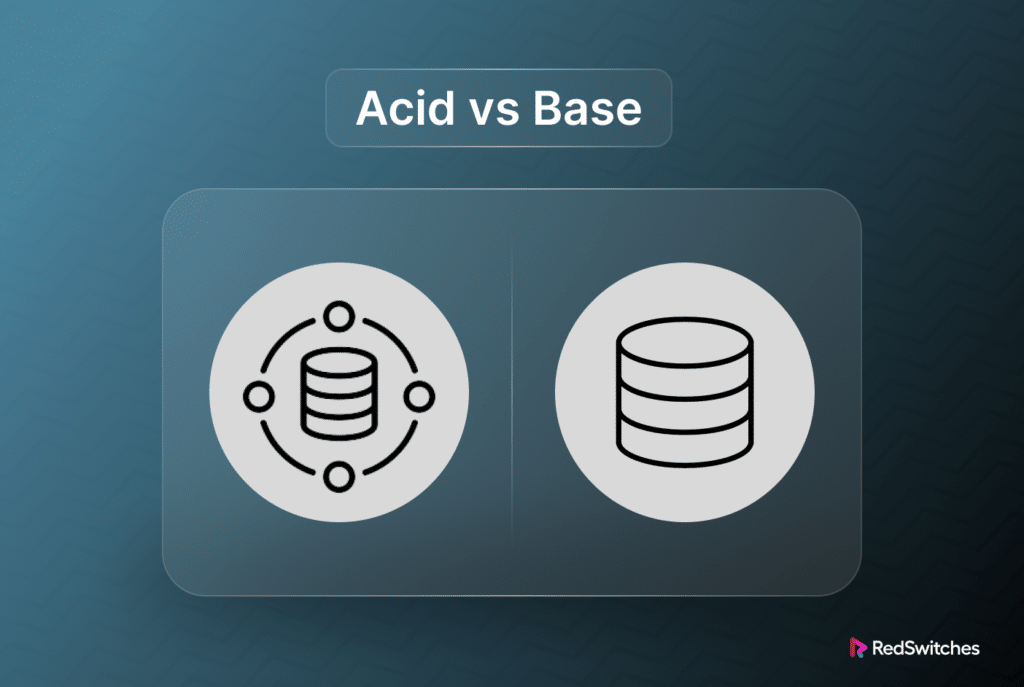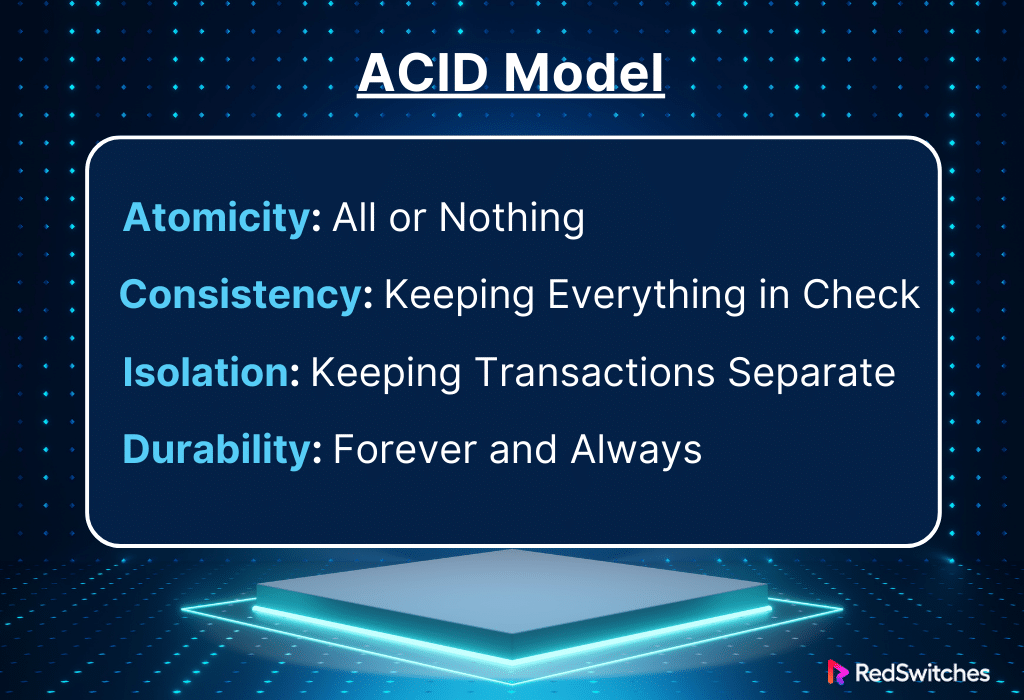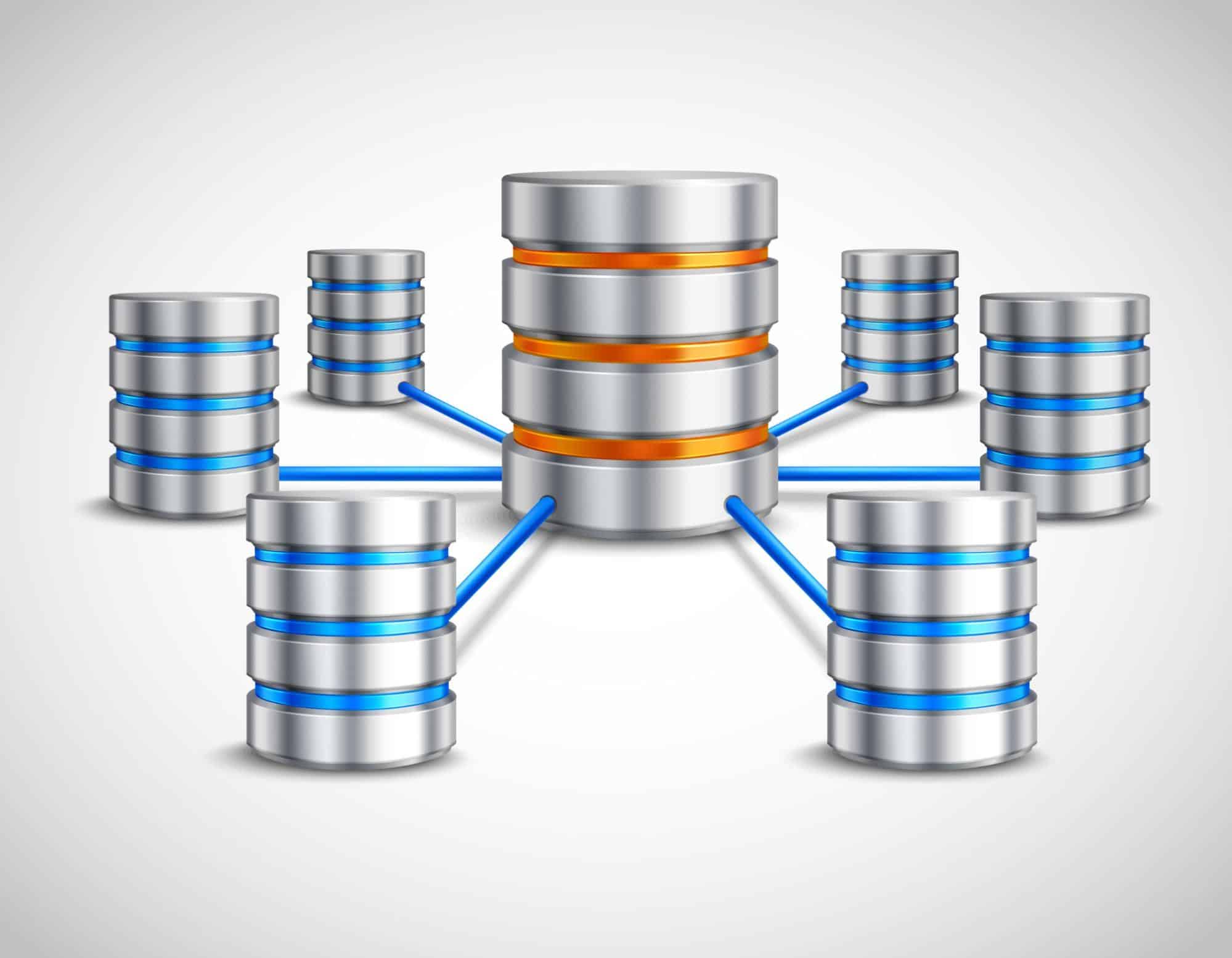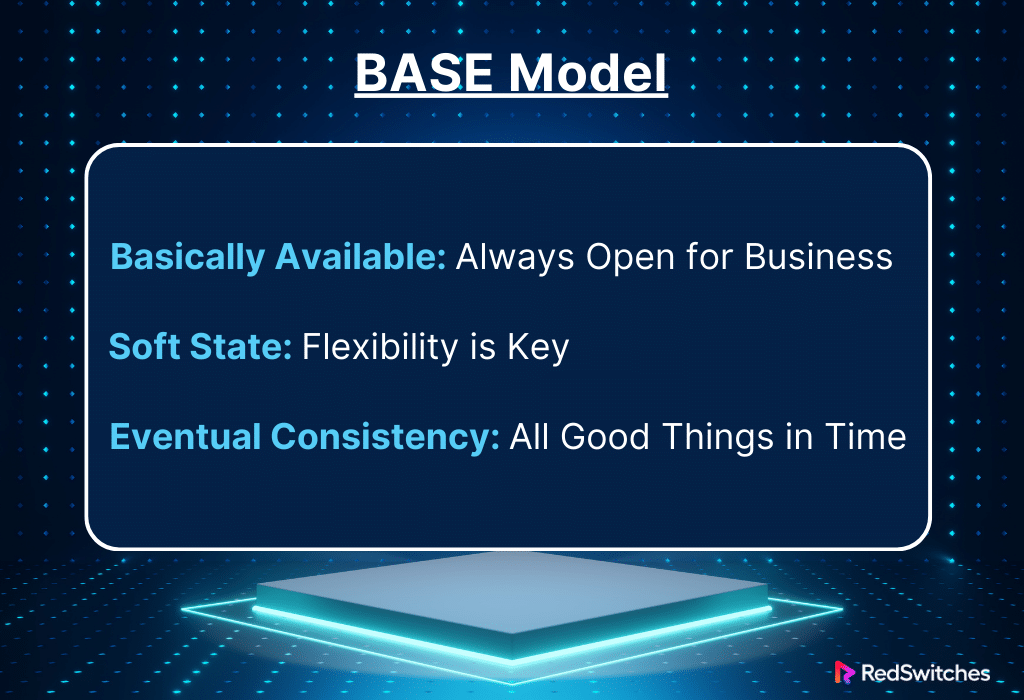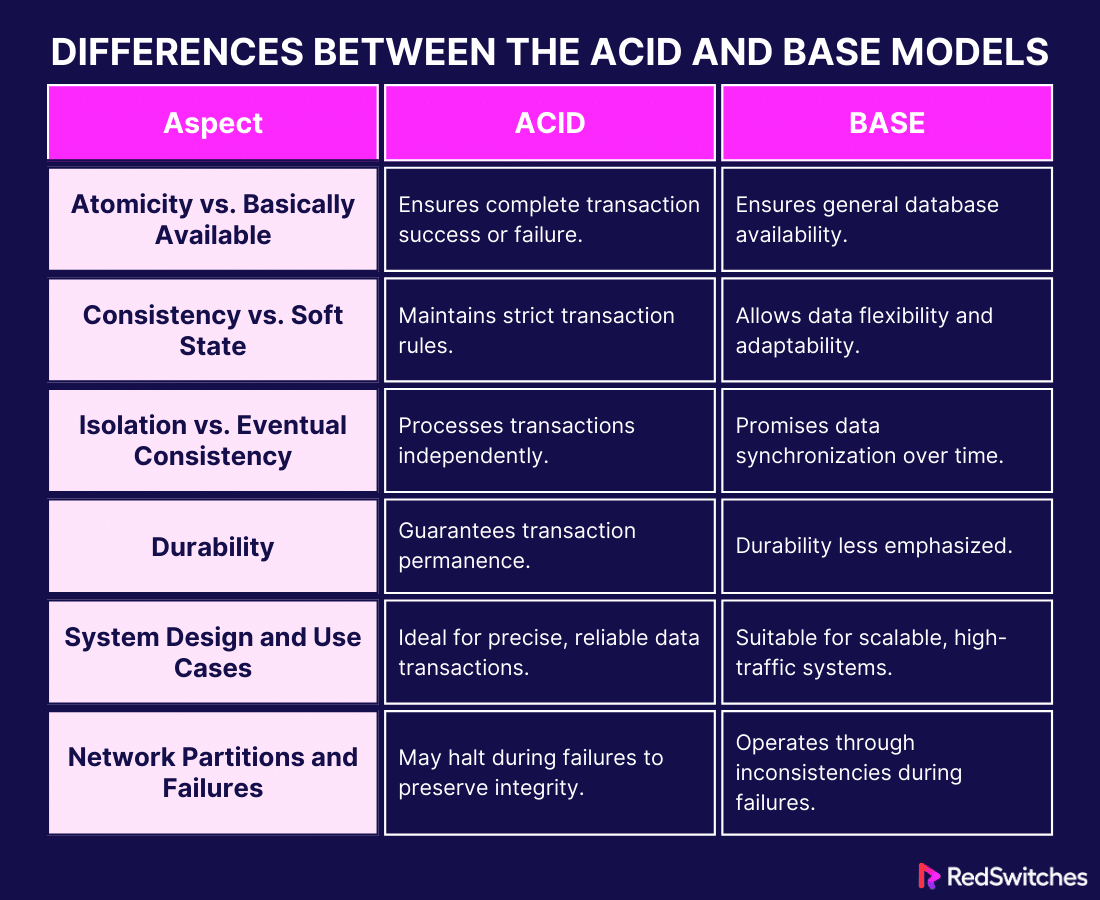Key Takeaways
- Two fundamental approaches are ACID vs. BASE to database transactions. Each model prioritizes different aspects of data management.
- ACID databases are the gold standard for accuracy. Choose ACID when transactions must always be complete, and data consistency is non-negotiable (financial systems, e-commerce orders).
- Built for flexibility and speed, a BASE is recommended for handling massive data volumes, rapid scaling, and situations where some temporary inconsistency is acceptable (social media, content platforms).
- Transactions either succeed fully or not at all (ACID), whereas the focus is on keeping the system running even with potential issues (BASE).
- Strict data rules for immediate accuracy (ACID) vs. a more adaptable approach allowing for temporary inconsistencies (BASE).
- Transactions happen independently to prevent conflicts (ACID), while the system achieves data consistency over time (BASE).
- Data is permanent, and transactions are ‘written in stone’, so even power outages won’t cause data loss, which is important for critical systems.
- Tailor your database to your use case. Consider the trade-offs between absolute accuracy (ACID) and high availability, even with some flexibility (BASE).
- Network reliability matters. BASE models may be better for systems where network partitions are likely, as they prioritize staying available.
- Hybrid approaches are emerging. New technologies allow databases to blend aspects of ACID and BASE for more nuanced, real-world solutions.
In the world of databases, there’s a big showdown between two heroes: ACID and BASE. These are big ideas that guide how databases manage your data. ACID stands for Atomicity, Consistency, Isolation, and Durability. BASE stands for Basically Available, Soft state, Eventual consistency. Each one has its own way of doing things.
Why should you care? Because how we store, get, and handle data is important today. We make a lot of data every day. Every day, we create about 328.77 million terabytes of it. That’s a huge amount. This data is all the new stuff we make, collect, copy, or use. Each year that adds up to about 120 zettabytes, or 0.33 zettabytes daily. Choosing between ACID and BASE is a big deal because of this.
Like reading your favorite book, let’s make “ACID vs BASE” easy to understand. Get ready to learn about how databases work in a fun way!
Table of Contents
- Key Takeaways
- What is a Modern Database (DB)?
- ACID Model: Ensuring Precision and Reliability in Data Transactions
- BASE Model: Embracing Flexibility and Availability in Data Management
- ACID vs BASE Databases: Exploring the Differences
- Atomicity vs. Basically Available: A Tale of Consistency and Availability
- Consistency vs. Soft State: Navigating Reliability and Adaptability
- Isolation vs. Eventual Consistency: Balancing Independence and Cohesion
- Durability: The Unyielding Pillar of Data Permanence
- System Design and Use Cases: ACID vs BASE Tailoring Solutions
- Network Partitions and Failures: Navigating ACID vs BASE Challenges
- Which Model To Choose? Navigating the ACID vs BASE Decision
- Conclusion
- FAQs
What is a Modern Database (DB)?
Credit: Freepik
Let’s take a tour through the world of modern databases. Look at a database as an enormous, magical bookshelf that reaches your vision, packed with all the knowledge you could possibly want. These days, a database is just like this bookcase but with superpowers.
In simple terms, a database is where we store and retrieve data. But a modern database? It’s so much more. It’s intelligent, fast, and incredibly flexible. It’s like comparing a wizard’s spellbook to a regular diary. Modern databases handle text, photos, videos, complex data structures, and even real-time data from sensors and social media.
These databases are built to handle the challenges of today’s world: vast amounts of data (we’re talking about data so big it’s measured in zettabytes!), users from all over the globe accessing this data simultaneously, and the need for this data to be secure and available 24/7.
But here’s where it gets even more enjoyable. Modern databases come in different shapes and sizes, each with unique abilities. Some are great at keeping data super organized and consistent (like our ACID model), while others are more about being flexible and available, even if everything isn’t always perfect (hello, BASE model).
A modern database is the brain and memory of almost every digital service you love and use daily. From your favorite social media apps storing your photos and posts to online stores keeping track of all their products and your orders, modern databases are the unsung heroes keeping our digital world spinning. So, when discussing “ACID vs BASE,” we discuss different ways these amazing databases can work their magic!
Also Read What Is RDBMS And How It’s Different From DBMS?
ACID Model: Ensuring Precision and Reliability in Data Transactions
When we talk about the ACID model in modern databases, we’re exploring a world where precision, reliability, and strict order are the names of the game. ACID stands for Atomicity, Consistency, Isolation, and Durability.
Let’s break this down into simpler terms using an everyday analogy.
Atomicity: All or Nothing
Think of atomicity like a light switch, on or off. In database terms, a transaction (a series of operations) must be fully completed or not done at all. If you’re saving a photo and your phone suddenly turns off, atomicity ensures that a half-saved, corrupted photo doesn’t mess up your gallery.
Consistency: Keeping Everything in Check
Consistency in the ACID model is like having a strict rulebook. Every transaction must follow specific rules (like not allowing harmful amounts in your bank account). This ensures that all data is correct and valid according to the defined rules, keeping your database error-free and reliable.
Isolation: Keeping Transactions Separate
Isolation is like having private rooms for each transaction. Even if many transactions occur simultaneously, isolation ensures they don’t trip over each other. This means your online shopping cart doesn’t get mixed up with someone else’s, ensuring a smooth, error-free experience.
Durability: Forever and Always
Credits: Freepik
Finally, durability is the superhero’s promise of your database. Once a transaction is completed, it’s stored permanently. Even if there’s a power cut or system crash, you won’t lose that important document you worked on.
The ACID model is like the meticulous planner of the database world. It’s perfect for situations where accuracy is critical, like banking or booking flights. In these scenarios, “acid vs base” isn’t just a technical choice; it’s about ensuring data is handled carefully and precisely.
Also Read What is data Integrity? Why is it important in database designs?
BASE Model: Embracing Flexibility and Availability in Data Management
Diving into the BASE model of database transactions is like stepping into a world where flexibility and availability reign supreme.
BASE stands for Basically Available, Soft state, and Eventual consistency. This model takes a more relaxed approach than the strict order of ACID, but don’t be fooled – it’s a powerhouse in its own right.
Basically Available: Always Open for Business
Imagine your favorite ice cream shop. It’s open almost all the time, right? That’s what ‘Basically Available’ in BASE is about. The model ensures the database is always available, even during failures or maintenance. So, if you’re browsing your favorite social media app, you can still see posts and pictures, even if some features might be temporarily down.
Soft State: Flexibility is Key
‘Soft State’ is like having a messy yet functional room. It means the database doesn’t always need to be perfectly consistent at all times. It can be in a state of change, adapting to new data, or situations. This flexibility allows for faster responses and more scalability, especially in systems where data is constantly changing, like real-time analytics or large-scale web applications.
Eventual Consistency: All Good Things in Time
‘Eventual Consistency’ is the promise that, eventually, everything will be in order. It’s like knowing that even if your room is a bit messy now, you’ll clean it up by the end of the day. In database terms, it means that while the system might not always be perfectly in sync, it will eventually become consistent. This is especially useful in distributed systems where immediate consistency is not critical.
The BASE model thrives in environments where availability and scalability are more important than immediate consistency. Think of extensive social networks or e-commerce sites where handling massive data and user requests is the priority. In these cases, “acid vs base” becomes a choice between strict order and dynamic flexibility.
Credits: Freepik
In conclusion, the BASE model offers a different yet equally powerful approach to data management. It’s the laid-back, adaptable counterpart to ACID, ensuring that even in a world of constant change and high demand, our digital experiences remain smooth and uninterrupted.
Also Read SQLite vs MySQL: Find The Best Database Management System For 2024
ACID vs BASE Databases: Exploring the Differences
In the world of databases, comparing ACID to BASE properties is like exploring the flavors of two amazing dishes. Each one has its strengths and perks. Knowing these can help you pick the right one for your data needs.
Think of the “ACID vs BASE” topic not as a fight, but as an exciting journey through different data management methods.
This trip will teach you what you need to know to choose the best model for your database, balancing dependability with flexibility.
Let’s start this adventure and uncover the secrets of these two important database transaction models!
Atomicity vs. Basically Available: A Tale of Consistency and Availability
In the intriguing “ACID vs BASE” narrative, the contrast between Atomicity (from ACID) and Basically Available (from BASE) is like comparing the steadfast reliability of a trusted old clock with the dynamic, ever-ready nature of a streaming service. Both are invaluable, but their approaches and priorities differ significantly.
Atomicity: The Guarantee of Completeness
Atomicity is the backbone of the ACID model, embodying a promise of completeness and integrity. It’s an all-or-nothing approach. Imagine building a house of cards; if one card falls, the entire structure collapses, and you start over. Similarly, if one part fails in an atomic transaction, the whole transaction is rolled back as if it never happened. This ensures that your data remains consistent and error-free.
- Uncompromising Reliability: Atomicity is crucial when even a tiny error can have significant consequences, like financial transactions.
- Consistent State Assurance: It maintains a consistent database state by ensuring that transactions are fully completed or not executed at all.
Basically Available: The Promise of Accessibility
On the flip side, ‘Basically Available’ from the BASE model focuses on ensuring the availability and accessibility of the database. It’s like a 24/7 convenience store, always open, regardless of what’s happening in the background. In a world where constant access to data is necessary, this aspect of BASE ensures that users can always retrieve and interact with data, even during technical challenges like server failures or network issues.
- High Availability: In high-traffic environments, such as social media platforms, users expect uninterrupted access, which is where Basically Available shines.
- Flexible and Resilient: It allows the system to remain operational and accessible, even if some parts of the database are temporarily inconsistent or undergoing maintenance.
Balancing Completeness with Accessibility
In comparing Atomicity and Basically Available, we see a balance between the need for complete, reliable transactions and the requirement for constant data availability. While Atomicity prioritizes maintaining a pristine state of data, Basically Available emphasizes ensuring that data is always within reach, even if imperfect.
Credits: Freepik
Understanding the distinct roles of Atomicity and Basically Available helps you choose the proper database model for your needs. It’s about matching the precision and reliability of Atomicity with the unwavering accessibility offered by Basically Available, ensuring that your data management strategy aligns perfectly with your application’s requirements. This comparison is a cornerstone in the “ACID vs BASE” discussion, highlighting the diverse strategies in modern database systems.
Also Read Data Duel: MongoDB vs PostgreSQL – Which Reigns Supreme?
Consistency vs. Soft State: Navigating Reliability and Adaptability
Credits: Freepik
In the compelling saga of “ACID vs BASE,” the comparison between Consistency (from ACID) and Soft State (from BASE) presents a fascinating dichotomy. It’s akin to the contrast between a well-oiled machine that performs with unwavering precision and a versatile artist who adapts to the changing environment. Both are effective, yet their methodologies and priorities diverge significantly.
Consistency: The Pillar of Predictability
Consistency in the ACID model is the stalwart guardian of data integrity. Imagine a world where everything follows a set of rules, like traffic lights on busy streets. Every transaction in an ACID-compliant database adheres to these predetermined rules, ensuring data remains accurate, reliable, and free from discrepancies.
- Unwavering Rules and Standards: Consistency ensures that all transactions transform the database from one valid state to another, maintaining data integrity.
- Dependable and Error-Free: It’s particularly crucial in systems where even minor inconsistencies can lead to significant issues, such as in accounting software or medical records.
Soft State: The Virtue of Flexibility
Soft State, a characteristic of the BASE model, embodies flexibility and resilience. It’s like a jazz musician improvising in a live performance, adapting to new scenarios while maintaining the flow. Soft State allows for impermanence and change in databases, acknowledging that the system may not always be perfectly consistent.
- Adaptability to Change: This approach is invaluable in environments where data is continuously evolving, such as real-time analytics or content streaming services.
- Resilience and Scalability: Soft State provides a level of tolerance for inconsistencies, making the system more resilient and capable of handling large volumes of data and traffic.
The Interplay of Predictability and Adaptability
The contrast between Consistency and Soft State in the “ACID vs BASE” dialogue highlights the balance between strict data integrity and the ability to adapt to rapid changes. While Consistency is about maintaining a predictable and error-free environment, Soft State offers a more fluid and scalable approach, accepting temporary inconsistencies for greater overall flexibility and availability.
Understanding the trade-offs between Consistency and Soft State is crucial in tailoring a database system to your specific needs. It’s about striking a balance between the rigid accuracy of Consistency and the dynamic adaptability of Soft State. This understanding not only enriches the “ACID vs BASE” discussion but also guides you in making informed decisions for efficient and effective data management strategies.
Isolation vs. Eventual Consistency: Balancing Independence and Cohesion
In the “ACID vs BASE” narrative, the juxtaposition of Isolation (from ACID) and Eventual Consistency (from BASE) presents a captivating study of balance. It’s like comparing the focused solitude of a scholar in a library with the communal, evolving buzz of a bustling café. Each has its unique approach to managing interactions and information flow.
Isolation: Ensuring Independent Transactions
Isolation in the ACID model is like giving each person in a crowded room a soundproof booth. In database terms, this means that each transaction is processed independently, without interference from or with other ongoing transactions. Imagine you’re editing a document at the same time as others. Isolation ensures that your changes don’t get mixed up with someone else’s, preventing potential chaos.
- Transaction Integrity: Isolation is critical when transactions need to be processed without mutual interference, like in financial trading systems.
- Preventing Data Conflicts: It maintains the accuracy and consistency of transactions, ensuring that concurrent operations don’t lead to data anomalies.
Eventual Consistency: Embracing a Synchronized Future
Eventual Consistency, a hallmark of the BASE model, is akin to a group of friends agreeing on a plan. They may start with different ideas but eventually come to a consensus. In database systems, this means that while the database might not be immediately consistent after a transaction, it will become consistent over time.
- Flexibility and Performance: This approach is beneficial in distributed systems where immediate consistency isn’t required, but eventual data synchronization is necessary, like in social media feeds or content delivery networks.
- Scalability and Availability: Eventual Consistency allows the system to handle more transactions and users, offering better availability and user experience at the cost of immediate consistency.
Navigating the Trade-Offs
The contrast between Isolation and Eventual Consistency in “ACID vs BASE” highlights the strategic trade-offs between transactional independence and eventual data harmony. While Isolation focuses on maintaining the sanctity of individual transactions, Eventual Consistency is about ensuring that, in the end, all parts of the system synchronize harmoniously.
Understanding this distinction is crucial for database architects and developers. It helps in deciding whether the immediate and strict separation of transactions (Isolation) is more vital for their application or if they can afford a more relaxed, eventually consistent approach. This choice is a critical consideration in the “ACID vs BASE” debate, guiding the development of robust, efficient, and suitable database solutions for varying needs.
Also Read Cassandra vs MongoDB: Which NoSQL Database Should You Consider in 2024?
Durability: The Unyielding Pillar of Data Permanence
In the discourse of “ACID vs BASE,” Durability stands out as a unique and crucial concept within the ACID model, akin to a steadfast lighthouse enduring against relentless waves. It represents the unyielding commitment of a database to preserve data integrity and permanence, regardless of what calamities might strike.
The Essence of Durability in ACID
Durability in the ACID model is a promise that once a transaction is completed, it’s etched in stone, metaphorically speaking. This means the data is permanently recorded and won’t be lost even during a power failure, system crash, or other unforeseen disruptions. Imagine writing a letter and locking it in an unbreakable safe; that’s Durability for you.
- Immutable Transactions: Once a transaction is committed, it remains intact forever. This is critical when data loss, such as financial transactions or legal records, can have severe consequences.
- Ensuring Data Safety: Durability guarantees that completed transactions are safe and sound, providing a solid foundation of trust and reliability for database systems.
Durability’s Role in Modern Databases
Credits: Freepik
While Durability is a principle associated with the ACID model, its significance extends to all database systems. The assurance that data won’t be lost or corrupted in the modern data-driven world is paramount. Whether it’s personal data, business records, or sensitive government information, the durability of data plays a vital role in maintaining the integrity and continuity of operations.
- Building User Trust: In a world where data is gold, Durability helps build and maintain user trust. Knowing that their data is safe and permanent gives users confidence in the system.
- Foundation for Robust Systems: Durability is a cornerstone for building robust and reliable database systems, ensuring they can withstand and recover from adverse conditions without data loss.
The Universal Value of Durability
Durability, although a critical component of the ACID model, transcends the “ACID vs BASE” debate, underscoring its universal value in database design. It’s a testament to the fact that, no matter the database model or system, the permanence and reliability of data are fundamental.
As we advance in the technological realm, the role of Durability in safeguarding our digital legacy continues to be of paramount importance, making it a critical consideration in any database architecture.
System Design and Use Cases: ACID vs BASE Tailoring Solutions
In the grand “ACID vs BASE” narrative, understanding how to tailor system design and identify appropriate use cases for each model is like choosing the right tool for a job. It’s about aligning the strengths and characteristics of each model with the specific requirements and goals of different applications. Let’s explore how system design and use cases vary depending on whether ACID or BASE models are employed.
System Design with ACID: Precision and Safety First
When designing a system that employs the ACID model, the focus is on precision, safety, and maintaining strict data integrity. The ACID model is ideal for systems where transactions must be reliable and consistent without exception.
- Financial Systems: Banks and financial institutions rely on the ACID model to ensure that every transaction, whether a transfer or a deposit, is processed accurately and reliably.
- E-Commerce Platforms: Ensuring that orders, payments, and inventory management are handled precisely.
- Healthcare Systems: Patient records and medical transactions require the high level of integrity that ACID offers to maintain accurate and consistent medical histories.
System Design with BASE: Scalability and Flexibility
In contrast, a system designed with the BASE model prioritizes availability, scalability, and flexibility over strict consistency. BASE is well-suited for applications where the sheer volume of transactions and the need for high availability are critical.
- Social Media Platforms: Handling millions of posts, likes, and comments where immediate consistency is less critical than availability and speed.
- Content Distribution Networks (CDNs): Serving up vast amounts of content globally, focusing on speed and accessibility.
- Big Data Analytics: Systems that require real-time analysis and processing of large datasets where eventual consistency is acceptable.
Navigating the ACID vs BASE Landscape in System Design
Credits: Freepik
When designing a system, it’s crucial to consider the specific needs of the application:
- Transaction Integrity vs. System Availability: Decide whether the system requires strict transaction integrity (ACID) or if it can benefit from the high availability and flexibility (BASE).
- Scalability Needs: BASE models are often more scalable, making them suitable for applications anticipating high growth or large, distributed systems.
- Data Consistency Requirements: ACID is preferable for systems that cannot tolerate inconsistency, while BASE is suitable for applications where eventual consistency is acceptable.
Choosing the Right Model for Your Use Case
The choice between ACID and BASE models should be driven by the designed system’s specific use cases and requirements. It’s not about which model is better but which is more appropriate for the task. Understanding the unique attributes of each model allows system designers and developers to make informed decisions, ensuring that the database architecture aligns perfectly with the application’s goals and user expectations.
In conclusion, the “ACID vs BASE” decision is a fundamental aspect of system design, playing a pivotal role in tailoring database solutions to various applications’ diverse needs. By carefully considering the use cases and requirements, one can harness the full potential of either model, paving the way for efficient, reliable, and scalable systems.
Network Partitions and Failures: Navigating ACID vs BASE Challenges
In the intricate world of database systems, understanding how ACID and BASE models handle network partitions and failures is crucial. It’s like preparing for unpredictable weather; while both models aim to safeguard your data, they do so in different ways, akin to choosing between a sturdy umbrella and a flexible raincoat.
ACID: Rigor in the Face of Adversity
The ACID model faces network partitions and failures like a fortified castle, emphasizing consistency and reliability. It prioritizes maintaining the integrity of transactions, even if it means sacrificing availability temporarily.
- Handling Failures with Precision: In the event of a network partition or failure, ACID-compliant systems may halt operations to preserve the consistency and integrity of the data. This approach is akin to sealing the castle gates until the danger passes.
- Recovery and Consistency: Once the network issues are resolved, the system resumes operations, ensuring that all data remains consistent and intact.
BASE: Flexibility Amidst Uncertainty
Conversely, the BASE model adopts a more flexible approach, like a settlement that adapts to the changing environment. It’s designed to handle network partitions and failures by prioritizing availability and functionality.
- Continued Operation in Disruptions: BASE systems operate even during network partitions, ensuring that the system remains available and functional. This approach might lead to temporary inconsistencies but keeps the system running.
- Eventual Consistency Post-Failure: After the network issue is resolved, BASE systems work towards achieving eventual consistency, reconciling any discrepancies that occurred during the disruption.
Navigating Network Challenges: ACID vs BASE
Choosing between ACID and BASE in the context of network partitions and failures involves a strategic decision:
- Prioritizing Consistency vs. Availability: If your system cannot afford to have inconsistent data even temporarily, ACID is the way to go. However, BASE offers a suitable solution if maintaining operations and availability during network issues is more critical.
- System Resilience: BASE models may offer more resilience in distributed environments where network partitions are more common, ensuring continuous operation.
- Recovery and Integrity: ACID systems, while potentially less available during a network partition, ensure that once recovered, the data integrity is uncompromised.
Making the Right Choice
Understanding how each model responds to network partitions and failures is key in designing systems that can withstand and efficiently recover from such challenges. This aspect is crucial in the “ACID vs BASE” debate, especially in environments where network reliability is a concern. One can ensure optimal performance, reliability, and user satisfaction by aligning the system’s design with the anticipated network conditions and the application’s needs.
Also Read MySQL vs PostgreSQL: Exploring the 12 Critical Differences
This table succinctly captures the essential differences between the ACID and BASE models in the context of the aspects discussed.
Which Model To Choose? Navigating the ACID vs BASE Decision
When choosing between the ACID and BASE models for your database system, the decision can feel like selecting the right gear for a specific journey. Each model has its terrain where it performs best, and the key is to match the model to your specific needs and challenges. Let’s explore the factors that can guide you in making this pivotal choice.
Credits: Freepik
Understanding Your Applications Needs
- Data Integrity vs. Availability: ACID is your go-to model if your application demands strict data integrity where every transaction (like financial services) must be precise. On the other hand, if your application prioritizes availability and can tolerate some level of data inconsistency (like social media platforms), BASE is more appropriate.
- Scalability Requirements: Consider how much your system needs to scale. BASE models are typically more scalable and can handle more transactions, making them suitable for large, distributed systems.
- Consistency Needs: Evaluate how critical immediate consistency is for your application. ACID ensures immediate consistency, whereas BASE allows for eventual consistency.
Assessing the Environment
- Network Reliability: BASE’s tolerance for network partitions might be more beneficial if your system operates in an environment with frequent network issues.
- User Experience: Consider the impact on the end-user. If your application cannot afford downtime or slow performance during peak usage, BASE’s emphasis on availability might be more critical.
Long-Term Considerations
- Maintenance and Complexity: ACID systems can be more complex due to their strict transaction rules. Assess your team’s ability to manage and support the chosen model.
- Future Growth: Think about the future growth of your application. If you anticipate a significant increase in data volume or user base, opting for a more scalable model like BASE might be a wise choice.
Making an Informed Decision
In the end, the choice between ACID and BASE comes down to carefully analyzing your specific requirements, the nature of your data, and your users’ expectations. It’s not about which model is generally better but which is better for your unique situation.
- ACID: Choose when data accuracy and integrity are non-negotiable, and you can manage with the potential trade-off in scalability and flexibility.
- BASE: Opt for when scalability and high availability are crucial and you can accommodate eventual consistency.
The “ACID vs BASE” decision is strategic, and deeply intertwined with the nature of your application and its long-term goals. By thoroughly understanding your application’s requirements and each model’s strengths and limitations, you can choose to address your current needs and position your system for future success and growth. Remember, the right model is the one that aligns seamlessly with your vision, ensuring a robust and efficient database system.
Also Read 10 Key Differences: MongoDB vs Redis – The Perfect NoSQL Database of 2024
Can a Database Be Both ACID and BASE?
In database systems, whether a database can embody ACID and BASE characteristics is like asking if a car can be both a fuel-efficient city vehicle and a rugged off-road explorer. While these models seem mutually exclusive at first, the lines are becoming more blurred with technological advancements and innovative design. Let’s delve into this intriguing possibility.
Exploring the Middle Ground
- Hybrid Approaches: Modern database technologies increasingly explore hybrid models that blend ACID and BASE elements. These systems aim to offer the best of both worlds – ACID’s reliability and consistency and BASE’s scalability and flexibility.
- Contextual Implementation: Some systems are designed to operate primarily under one model but can switch to the other in certain contexts. For example, a system might use ACID properties for critical operations but rely on BASE principles for less critical data to improve performance and scalability.
Technological Innovations
- Advancements in Distributed Systems: With the rise of distributed computing, databases are being designed to handle the challenges of maintaining ACID properties while operating at the scale and efficiency of BASE.
- Sophisticated Data Management: Innovations in data management techniques allow for more nuanced approaches, where the strictness of ACID can be balanced with the pragmatism of BASE in different parts of the same system.
Real-World Applications
- E-Commerce Platforms: An e-commerce platform might use ACID transactions for order processing and payment systems but adopt BASE principles for user recommendations and browsing history, where immediate consistency is less critical.
- Financial Services: In financial applications, core transaction systems might adhere to ACID properties for accuracy and legal compliance, while peripheral systems like customer engagement tools might use BASE for better scalability.
Challenges and Considerations
- Complexity in Implementation: Creating a system that effectively balances ACID and BASE properties requires sophisticated architecture and careful planning. It can add complexity to the development and maintenance of the database system.
- Performance Trade-offs: While a hybrid approach aims to offer flexibility and consistency, it may involve trade-offs in terms of performance and complexity. The system must be carefully tuned to ensure that it effectively meets the specific requirements of different operations.
So, can a database be both ACID and BASE? The answer is increasingly leaning towards ‘yes,’ though with some caveats. Technological advancements enable more sophisticated and nuanced database systems that adapt their behavior to specific requirements.
However, achieving this balance requires careful design and a clear understanding of the trade-offs. As database technology continues to evolve, we may see more systems that successfully integrate the principles of ACID and BASE, offering a more versatile and robust solution for data management.
Conclusion
As we conclude our exploration into the fascinating world of database base vs acid management, it’s clear that this journey is much more than a technical deep dive.
Whichever model you prefer—the flexible durability of BASE or the exact precision of ACID—the important thing to remember is that both offer an infinite number of options. From the steadfast reliability of ACID in critical financial transactions to the dynamic scalability of BASE in handling vast social media interactions, the landscape of database management is rich with opportunities for innovation and growth.
And in this ever-evolving domain, having a reliable and knowledgeable partner can make all the difference. This is where RedSwitches comes into play. As a leader in top-tier database solutions, RedSwitches contributes to this technological revolution, providing knowledge and tools to make these difficult decisions simple for you to make.
Whether you’re looking to build a robust ACID-compliant system, harness the flexibility of BASE, or explore a hybrid approach, RedSwitches has the tools, talent, and technology to bring your vision to life. So, if you’re ready to take your database system to the next level or simply looking for expert guidance in choosing between ACID and BASE, reach out to RedSwitches today.
FAQs
Q. Is MongoDB an ACID or BASE database?
MongoDB, traditionally known for its BASE model approach, has made significant strides in supporting ACID properties, especially since version 4.0. It now offers ACID transactions for its document-based database system.
Q. What is BASE in databases?
BASE stands for Basically Available, Soft state, and Eventual consistency. It’s a database model that prioritizes availability, flexibility, and scalability over strict consistency. It’s commonly used in distributed systems where immediate consistency is less critical.
Q. Is MySQL an ACID or BASE?
MySQL is an ACID-compliant database system. It is designed to ensure Atomicity, Consistency, Isolation, and Durability in its transactions, making it suitable for applications where data integrity and reliability are crucial.
Q. Which database is best for ACID transactions?
Databases like MySQL, PostgreSQL, and Microsoft SQL Server are often considered some of the best options for ACID transactions. They provide robust support for transactional integrity and consistency, making them ideal for applications requiring high levels of data accuracy.
Q. What is the purpose of an ACID database?
The purpose of an ACID database is to ensure reliable processing of database transactions. It guarantees that all transactions are processed in a consistent, isolated, and durable manner, which is essential for maintaining data integrity and correctness, especially in systems like banking or inventory management.
Q. What databases use ACID?
Many relational database management systems (RDBMS) use ACID properties, including MySQL, PostgreSQL, Oracle Database, and Microsoft SQL Server. These databases are designed to ensure the reliability and integrity of data through strict adherence to ACID principles.
Q. What is the difference between acid and base database models?
Acid (Atomicity, Consistency, Isolation, Durability) and base (Basically Available, Soft state, Eventually consistent) are two different consistency models for databases. Acid databases prioritize strong consistency, while base databases prioritize high availability and partition tolerance.
Q. How do acid and base databases differ in transaction processing?
Acid databases ensure strong consistency and transactional integrity, meaning that transactions are processed with atomicity and isolation. Base databases prioritize availability and partition tolerance, allowing for eventual consistency and soft state handling during transaction processing.
Q. Why is choosing the right database model important?
Choosing the right database model is crucial as it directly impacts the consistency, availability, and performance of data storage and retrieval. Different use cases and application requirements may necessitate the selection of either an acid or base database model.
Q. What is the impact of a base database transaction model if a transaction fails?
In a base database model, if a transaction fails, it may result in the database being in an inconsistent state temporarily. However, the system will eventually converge to a consistent state due to eventual consistency properties.
Q. How do acid and base databases handle concurrent transactions?
Acid databases provide strong isolation for concurrent transactions to maintain data integrity, while base databases allow for eventual consistency and soft state handling, potentially leading to divergence in concurrent transactions until eventual convergence.
Q. What are the main differences between acid compliance and eventual consistency?
Acid compliance refers to strong consistency and immediate data validity in transactions, while eventual consistency allows for temporary data divergence with the assurance of eventual convergence to a consistent state over time.
Q. What is the role of a base database in managing concurrent transactions?
In managing concurrent transactions, a base database model prioritizes availability by allowing eventual consistency and soft state handling, enabling high availability and partition tolerance while potentially sacrificing strong consistency.
Q. How do acid and base databases differ in their approach to transaction rollback?
In acid databases, the entire transaction is rolled back if any part of it fails to maintain data integrity. In base databases, the system may allow parts of the transaction to commit, even if temporary data divergence occurs, to prioritize availability and eventual convergence.
